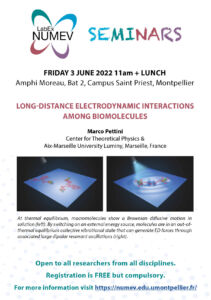NUMEV Seminar : « Long-distance electrodynamic interactions among biomolecules » by Marco Pettini
Cet évènement est passé !
Campus Saint Priest, bâtiment 2, amphi Moreau – 860, rue de St Priest, 34090 Montpellier.
 Les Séminaires NUMEV sont ouverts à un large public de chercheurs et chercheuses de toutes disciplines, qui souhaitent en savoir plus sur les domaines de recherche actuels de la communauté NUMEV-MIPS (Mathématiques, Informatique, Physique et Systèmes) ou sur les possibilités de développer ses compétences et savoir-faires.
Les Séminaires NUMEV sont ouverts à un large public de chercheurs et chercheuses de toutes disciplines, qui souhaitent en savoir plus sur les domaines de recherche actuels de la communauté NUMEV-MIPS (Mathématiques, Informatique, Physique et Systèmes) ou sur les possibilités de développer ses compétences et savoir-faires.
Long-distance electrodynamic interactions among biomolecules
By Marco Pettini, Center for Theoretical Physics and Aix-Marseille University Luminy, Marseille, France
Abstract
In the first part of this talk I will report on the theoretical and experimental findings about the activation of out-of-equilibrium collective oscillations of a macromolecule as a classical phonon condensation phenomenon.
In the second part of the talk, I will report on the outcomes of two other recent and independent experiments that, based on two different physical effects detected by fluorescence correlation spectroscopy and terahertz spectroscopy, respectively, demonstrate the activation of resonant electrodynamic intermolecular forces acting at long distances. The activation of these long- range/long-distance electrodynamic interactions among biomolecules (proteins) is a consequence of the activation of the out-of-equilibrium collective molecular oscillations discussed in the first part of the talk. The existence of these forces was predicted by both classical and quantum electrodynamics, however, they have never been hitherto experimentally observed.
The discovery of these new forces acting between biomolecules could have considerable impact on our understanding of the dynamics and functioning of the molecular machines at work in living organisms. In fact, it has been found that the model proteins used can mutually attract at a distance as large as 1000 Angstroms, which is by far larger than all the other intermolecular interactions usually considered in action in living matter. In addition to thermal fluctuations that drive molecular motions randomly, these resonant (and thus selective) electrodynamic forces may contribute to molecular encounters in the crowded cellular space.
